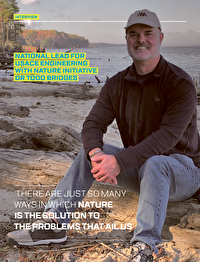From an early fascination in oceanography, nature has played a defining role in the career of Dr Todd Bridges. With a decade’s investment in the Engineering With Nature® initiative, he has seen that sustainability and engineering can go hand-in-hand providing economic, environmental and social benefits. His focus now is to build on that foundation – to encourage and facilitate collaboration across sectors, public and private, to advance and accelerate Engineering With Nature practice.
How and why did the Engineering With Nature initiative begin?
The U.S. Army Corps of Engineers (USACE) formally started the Engineering With Nature (EWN) initiative in 2010. The short answer to why we started EWN was that it was time. In the 1960s, there were several ideas beginning and maturing. For example, Howard Odum, started the idea of ecological engineering, combining ecosystems with society and human need. Ian McHarg, a landscape architect, published his seminal work Design with Nature in 1969, combining natural systems and approaches with the practice of landscape architecture. Over the decades, those approaches have matured and grown. When we consider the challenges and opportunities that present themselves to the world in the 21st century, we need to apply these ideas as we pursue infrastructure development. In the 20th century, we built a lot of infrastructure with steel, concrete, rock and asphalt. In the 21st century, how will we pursue investment and development of infrastructure? There is a fantastic opportunity, I believe, worldwide to incorporate nature into engineering in a more tangible and substantive way – to diversify and really expand as well as increase the value that can be generated from such projects.
Your career with USACE spans nearly 30 years. How did your background spark your interest to work on the initiative?
It all began when I was a boy. When I was growing up, I watched Jacques Cousteau on television. I was completely captivated and fascinated by the ocean and in particular, the biology of the ocean. I consciously remember at the age of 10 or 11 deciding that this was what I was going to do. I went to college and got my bachelor’s and master’s in biology, and then did my doctoral work in oceanography. So, I had a natural sciences background with a focus on the ocean and marine systems, and then I came to work for an engineering organisation, the U.S. Army Corps of Engineers. It was here that I benefited from daily interaction and collaboration with engineers. They have a different educational foundation and a different way of thinking about their work, problems and solutions that I’ve come to really appreciate. When scientists and engineers work together, it can be a very powerful combination that is complimentary in so many regards. Over the years, with my education and professional experience, Engineering With Nature came together in my thinking in terms of what a solution could look like. A solution being something that combines engineering and nature together.
Not everyone can say their passion turned into their work.
No, to be able to combine what you do many hours a day with work that provides you with personal satisfaction and fulfilment, I mean, that’s the ideal. There’s nothing that compares.
There have been so many USACE projects over the past decade. Is there one that stands out for you and why?
It’s so difficult to choose. With the publication of both volumes one and two of the Engineering With Nature Atlas, there are a total of 118 projects from around the world described in those books. 50 of those projects are USACE projects that go back many years. We started the Engineering With Nature initiative formally in 2010, but we did so recognising that there are decades of prior practice we could look to for examples. We’re working to elevate this approach to solution development and, as I’ve said many times, to make the exceptional projects of the past commonplace in the future.
What has been accomplished over the last several years is not contained in one project, more a network of activities. In coastal New Jersey, we have worked for several years with many organisations, including our Philadelphia District of the Corps of Engineers, state agencies, the non-profit world, the private sector and academia. Through that collaboration, an initiative called the Seven Mile Island Innovation Laboratory (SMIIL) was formed. This group is building first of their kind projects, drawing from the principles and practices of Engineering With Nature. It’s a beautiful thing to behold when alignment occurs across organisational boundaries and mandates to really deliver nature-based solutions.
I’d also like to mention another more recent example, where Engineering With Nature has been working closely with the U.S. Air Force. At Tyndall Air Force Base on the Gulf Coast of Florida, Hurricane Michael did a huge amount of damage when it struck in 2018. Right now, the U.S. Department of Defense is investing nearly US$ 5 billion to rebuild this 30,000-acre military base in a way that is resilient with respect to future conditions, climate change and future storms. Part of the approach that we’re taking there through Engineering With Nature is to make investments in the natural landscape. There’s a beautifully complex, natural landscape there that includes islands and beaches, dunes and back bay environments, reefs and wetlands. Our aim is to invest in those natural landscapes to provide resilience to the mission. It’s a prime example of the connection between nature-based solutions and national security infrastructure.












